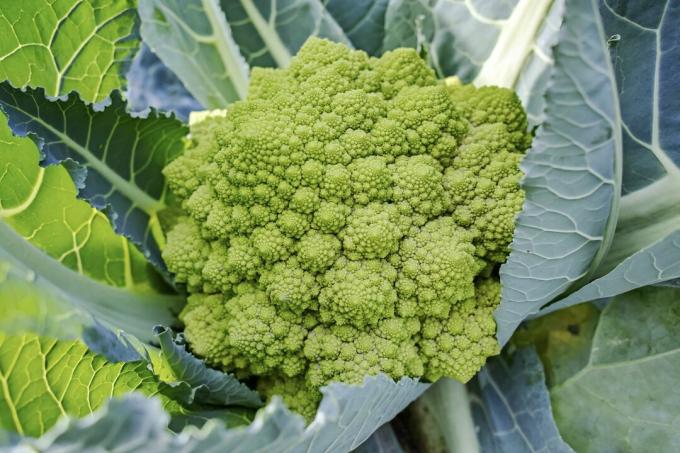Growing Romanesco in your own garden: We present suitable varieties and give tips and tricks from sowing, care and fertilization to harvesting.

the Romanesco cabbage (Brassica oleracea convar. botrytis var. botrytis) is also known as minaret or turret cabbage. This particularly beautiful type of cabbage gets its name from the shape of its inflorescences, which are tower-like or grow in the shape of minarets. Although it is often claimed that this type of cabbage is a combination of cauliflower and broccoli is. But the fact is that the Romanesco is a pure variety of cauliflower.
The Romanesco cabbage has a very intense aroma compared to most other types of cabbage, especially compared to the more common cauliflower. The vitamin content is also a lot higher than in the more well-known cauliflower. The buds of both cauliflower and romanesco are eaten. In the case of the latter, these develop later in comparison to other conspecifics and are therefore somewhat smaller.

Varieties of Romanesco
You can buy seeds for growing Romanesco in your own garden online. Ready-made plants are also available in selected garden shops. Choose the right variety. We have put together some variety recommendations for you:
-
Varieties for year-round cultivation:
- Celio F1: large-growing variety, year-round cultivation possible with good yields.
-
Varieties for growing in late summer and autumn:
- Veronica F1: uniform beautiful buds, high resistance to powdery mildew.
- white gold: high quality Romanesco buds with high yield.
- Navona F1: particularly beautiful and heavy buds.
- Gitano F1: compact variety with high yield and great resistance to downy mildew.
Growing Romanesco - this is how it works step by step: We'll take you through the gardening year with brief instructions
- You can start sowing at the end of February. A wind-protected cold frame (fleece cover for frosty nights) or a sunny windowsill is suitable. Direct sowing is only advisable from April. A temperature of around 12 °C is recommended for good germination. The first successes will be noticeable after just one week. When germinating on the windowsill, after approx. Prick out the young plants after about 3 weeks and transfer to suitable pots (P9). Here they have enough space to grow well.
- In April, the bed must be prepared for planting out. This is very important, because the Romanesco not only needs a sunny spot, but also nutrient-rich soil. Fresh compost or a primarily organic organic fertilizer like our Plantura Organic Tomato Fertilizer with a long-term effect, the soil conditions can improve significantly.
- During April, the cabbage cuttings are planted in the garden. The Romanesco needs an area of about 50×50 cm per plant (smaller varieties are also satisfied with less).

- During growth, you can additionally supply the plants with a nitrogenous fertilizer at intervals of 2 weeks. However, you should stop four weeks before harvest, otherwise the taste will be lost!
- During dry summer days, the pretty Romanesco needs more water. Regular weeding and loosening of the surrounding soil will reward the Romanesco with a higher yield and even more aroma.
- Depending on the variety, you must check the inflorescences at least every other day during harvest time. Before the cabbages start to loosen up, it's time to harvest. Typically, most Romanesco strains are harvested before the outer covering leaves fully reveal the green and so delicious bud cluster. For harvest, the Romanesco cabbage is cut off and the remaining parts of the plant can be disposed of on the compost heap.

The variety of cabbage varieties is great - we present the most important ones Types and varieties of cabbage in our overview.



